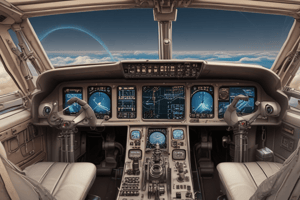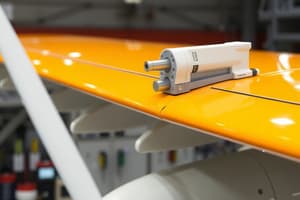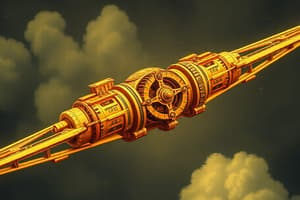Podcast
Questions and Answers
What components are included in the primary Flight Control System (FCS)?
What components are included in the primary Flight Control System (FCS)?
The primary FCS includes the components that control the two ailerons, six spoilers, two elevators, and one rudder.
How are the flight control surfaces actuated and controlled?
How are the flight control surfaces actuated and controlled?
The flight control surfaces are hydraulically actuated and electrically controlled with fly-by-wire technology.
What is the significance of the System Power On Self-Test (SPOST) in the aircraft's flight control system?
What is the significance of the System Power On Self-Test (SPOST) in the aircraft's flight control system?
The SPOST is a feature of the FCC channels that runs when power is first applied, and it checks the system for proper functioning.
How does the aircraft's control system handle the situation when both FCCs (all four channels) are inoperative?
How does the aircraft's control system handle the situation when both FCCs (all four channels) are inoperative?
What are the primary flight control surfaces that remain operational if one hydraulic system is lost?
What are the primary flight control surfaces that remain operational if one hydraulic system is lost?
What is the purpose of the Backup Flight Control Unit (BFCU)?
What is the purpose of the Backup Flight Control Unit (BFCU)?
What are the two types of primary flight control surface actuators mentioned in the text?
What are the two types of primary flight control surface actuators mentioned in the text?
What are the three modes of operation for the EBHA?
What are the three modes of operation for the EBHA?
What are the sub-modes of the Normal mode under the Flight Control System (FCS)?
What are the sub-modes of the Normal mode under the Flight Control System (FCS)?
What is the pitch response at speeds above approximately 135 KCAS?
What is the pitch response at speeds above approximately 135 KCAS?
Under what conditions will the FCS be in the Cruise sub-mode?
Under what conditions will the FCS be in the Cruise sub-mode?
What indications will be displayed if the aircraft is near its angle of attack (AOA) limit value of 0.96?
What indications will be displayed if the aircraft is near its angle of attack (AOA) limit value of 0.96?
What conditions need to be satisfied for the Flight Control System (FCS) to be in the AOA limiting sub-mode?
What conditions need to be satisfied for the Flight Control System (FCS) to be in the AOA limiting sub-mode?
What triggers the entry into the AOA limiting sub-mode, and what are the indications of being in this sub-mode?
What triggers the entry into the AOA limiting sub-mode, and what are the indications of being in this sub-mode?
What are the conditions for the Flight Control System (FCS) to be in Alternate mode, and how is it primarily indicated?
What are the conditions for the Flight Control System (FCS) to be in Alternate mode, and how is it primarily indicated?
What behavior is expected while in Direct mode, and how is it primarily indicated?
What behavior is expected while in Direct mode, and how is it primarily indicated?
What are the conditions for the Flight Control System (FCS) to be in AOA limiting sub-mode, and what are the indications of being in this sub-mode?
What are the conditions for the Flight Control System (FCS) to be in AOA limiting sub-mode, and what are the indications of being in this sub-mode?
What conditions need to be satisfied for the Flight Control System (FCS) to be in Alternate mode, and how is it primarily indicated?
What conditions need to be satisfied for the Flight Control System (FCS) to be in Alternate mode, and how is it primarily indicated?
How does the aircraft's control system handle the situation when both FCCs (all four channels) are inoperative?
How does the aircraft's control system handle the situation when both FCCs (all four channels) are inoperative?
What is the significance of the System Power On Self-Test (SPOST) in the aircraft's flight control system?
What is the significance of the System Power On Self-Test (SPOST) in the aircraft's flight control system?
Under what conditions will the Flight Control System (FCS) be in the AOA limiting sub-mode, and how does the system handle the situation during landing and flare?
Under what conditions will the Flight Control System (FCS) be in the AOA limiting sub-mode, and how does the system handle the situation during landing and flare?
What is the purpose of the AOA limiting sub-mode in the Flight Control System (FCS)?
What is the purpose of the AOA limiting sub-mode in the Flight Control System (FCS)?
How is the entry into the AOA limiting sub-mode triggered, and what are the indications of being in this sub-mode?
How is the entry into the AOA limiting sub-mode triggered, and what are the indications of being in this sub-mode?
Under what conditions will the Flight Control System (FCS) be in Alternate mode, and how is it primarily indicated?
Under what conditions will the Flight Control System (FCS) be in Alternate mode, and how is it primarily indicated?
What is the behavior of the Flight Control System (FCS) in Direct mode, and how is it primarily indicated?
What is the behavior of the Flight Control System (FCS) in Direct mode, and how is it primarily indicated?
What are the conditions for the Flight Control System (FCS) to enter the Yaw Control sub-mode, and what is the function of the yaw damper in this sub-mode?
What are the conditions for the Flight Control System (FCS) to enter the Yaw Control sub-mode, and what is the function of the yaw damper in this sub-mode?
Flashcards are hidden until you start studying
Study Notes
Flight Control System (FCS) Overview
- The primary FCS consists of several key components: flight deck controls, displays, Flight Control Computers (FCCs), air data sensors, inertial sensors, flight control actuators, and flight control surfaces.
- Communication among these components is established through analog and digital methods, primarily using ARINC 429 digital communication buses.
Hydraulic System Connections
- Hydraulic systems for left and right actuators ensure all primary flight control surfaces remain functional even if one hydraulic system fails, except for a pair of mid or inboard spoilers.
Flight Deck Control Devices
- Control devices include a conventional control wheel, rudder pedal assembly, speed brake handle, trim control switches, flap handle, and flight control reset switch.
- Each control has multiple position sensors that feed data to the FCCs.
Backup Flight Control Unit (BFCU)
- BFCU maintains emergency flight capability if all FCC channels become unavailable.
- Located under the cabin floor, it processes signals from flight deck control sensors and controls electric backup hydraulic actuators.
Flight Control Computers (FCCs)
- The primary FCS features two dual-channel FCCs located in Left and Right Electronics Equipment Racks.
- Each channel consists of a command lane and a monitoring lane, designed to ensure system integrity through self-checking operations.
Actuator Types and Operations
- Two actuator types: Hydraulic Actuators (HAs) and Electric Backup Hydraulic Actuators (EBHAs) allow for electrical control and hydraulic power.
- HAs operate through commands sent to a hydraulic valve, while EBHAs can utilize a built-in motor-pump for backup when standard hydraulic sources fail.
Control Surface Operation Modes
- Primary FCS operates in five modes: Normal, Alternate, Direct, Backup, and Maintenance.
- Normal mode includes four sub-modes: On-ground, Takeoff and Landing, Cruise, and Angle of Attack (AOA) Limiting.
Normal Mode Conditions
- Requires normal operation of air data probes and inertial reference units, with no conflicting data.
- On-ground sub-mode activates if weight on wheels is confirmed or specific wheel speed conditions are met.
Control Response Dynamics
- Pitch Control: Direct translation of column deflection to elevator command, tailored for airspeed conditions.
- Roll Control: Wheel deflection controls ailerons and roll spoilers; deflection proportions adjust with flap position and airspeed.
- Yaw Control: Below 60 KCAS, rudder deflection adheres strictly to pedal input; effectiveness transitions with speed.
Flap Actuation System
- Flap system components include the Flap Electronic Control Unit (FECU), Flap Hydraulic Control Module (HCM), and associated actuators.
- Designed for optimal control and efficiency during varied flight operations, including takeoff and landing.
Trim Control System
- Trim switches for pitch, roll, and yaw axes facilitate adjustments in control surface positioning.
- Stabilizer trim operates at a maximum rate of 0.4 degrees/second, enhancing pilot control.
Safety Features
- Built-in test capabilities for system diagnostics, with automatic tests upon each power cycle and additional checks by maintenance personnel.
- Redundancy measures in place to ensure continued operation following damages such as birdstrikes or bursts.
Failure Management
- BFCU assumes control of vital flight surfaces rapidly if all FCC channels fail.
- Control surface travel is limited in backup mode to prevent over-controlling during high-speed operations.### Flight Control System (FCS) Overview
- The FCS is controlled by Flight Control Computers (FCCs) that manage flight control surface operations through Control Laws.
- Each FCC channel can independently operate the entire FCS, ensuring safety redundancy.
- Backup Flight Control Unit (BFCU) can control key surfaces if all FCCs fail.
- Aircraft can be dispatched with restrictions if one FCC channel is inoperative.
Safety Features
- Primary actuators protect control surfaces from wind gusts (up to 65 knots) while on the ground without hydraulic pressure.
- There is no mechanical gust lock mechanism.
System Power On Self-Test (SPOST)
- SPOST is part of both the Cockpit Preflight Inspection and Before Starting Engines checklists.
- During the first flight of the day, SPOST checks are executed with specific battery setups to assess health accurately.
- A successful SPOST concludes with the system stability indicated by the Flight Control synoptic.
Operational Mechanisms
- If SPOST fails, the FCC reports an FCS Test Fail caution; power cycling is needed to reset.
- APU GEN powers essential buses, facilitating FCC operations.
Component Structure
- The primary FCS includes ailerons, elevators, rudder, and spoilers—all hydraulically actuated and electrically controlled using fly-by-wire technology.
- Control mechanisms such as control wheels, columns, and rudder pedals use position sensors connected to the FCC.
- The backup controls ensure safe operation during mechanical jams.
Communications and Redundancy
- FCCs communicate with system components via ARINC 429 digital buses, providing redundancy to mitigate failures.
- Key inputs from sensors are included for computing flight surface position commands.
FCC Configuration
- There are two dual-channel FCCs that provide fault tolerance through self-checking mechanisms.
- Each channel includes command and monitoring lanes, ensuring independent operation and integrity.
BFCU Responsibilities
- The BFCU maintains emergency control and reports status to the FCCs.
- In an emergency, it can take over control Surfaces (aileron, spoiler, elevator, rudder) with limited travel to prevent overstressing.
Actuator Types
- The FCS utilizes Hydraulic Actuators (HAs) and Electric Backup Hydraulic Actuators (EBHAs) for surface manipulation.
- HAs are powered by hydraulic systems, while EBHAs can operate in electrical modes using dedicated motors.
- Actuators can switch between states (Hydraulically Active and Damped Bypass) for normal and gust protection.
Flight Control Check Procedures
- Specific procedures during cockpit checks are outlined for successful SPOST execution and control verification.
- Proper power management is crucial during pre-flight checks to avoid unnecessary caution messages.
Key Systems Overview
- Components such as the Flap Electronic Control Unit (FECU) and Horizontal Stabilizer Control Unit (HSCU) support the FCS.
- Position sensors and artificial feel mechanisms enhance pilot control and feedback.
Maintenance and Monitoring
- Intuitive test systems are built into the FCC to automatically check sensor and actuator health, with options for maintenance personnel to conduct additional tests.### Damped Bypass Actuators (DBA) and EBHA
- Pilots can manually operate ailerons during preflight to feel the damped bypass actuators when hydraulic pressure is unavailable.
- EBHA operates in three modes: Hydraulically Active, Electric Backup, and Damped Bypass.
- In normal operation, the EBHA has identical inputs and functions as Hydraulically Active.
- In case of engine-driven hydraulic failure, an Electrical Backup pump powers the EBHA actuator.
- Each EBHA REU receives power from two circuit breakers: one from the UPS bus and one from Main DC buses.
- The rudder REU employs two UPS supplies routed through separate rotor burst zones for redundancy.
- Motor Control Electronics (MCE) manage the EBHA electric motor during Electric Backup state due to failures.
- MCE remains in standby when EBHA is in normal state, processing commands and relaying data back to the FCC for monitoring.
- Each FCC has a dedicated MCE bus that maintains control even during REU failures.
Flight Control System (FCS) Modes
- The primary FCS features five operational modes: Normal, Alternate, Direct, Backup, and Maintenance.
- Mixed mode operation is not allowed; all flight controls must be in the same mode.
Normal Mode
- Normal mode integrates four sub-modes: On-ground, Takeoff and Landing, Cruise, and Angle of Attack (AOA) Limiting.
- Activation conditions include consistent data from two or more air data probes, functioning IRUs, and horizontal stabilizer status.
On-ground Sub-mode
- Activates if weight on wheels (WOW) sensors indicate weight presence or wheel speed conditions are met.
- The pitch, roll, and yaw trim indicators display a green band in this mode.
- AOA limiting is disabled when in On-ground sub-mode.
Takeoff and Landing Sub-mode
- Triggers when On-ground logic and AOA limiting conditions are unmet, and the landing gear handle is down or flap handle exceeds 5°.
- Similar pitch control dynamics as in On-ground sub-mode apply, maintaining control responsiveness.
- Roll augmentation reduces unexpected roll rates, ensuring stable flight.
Cruise Sub-mode
- Engages when On-ground or AOA limiting conditions are not met, with autopilot engaged, or when both landing gear and flaps are retracted.
- Aircraft response is designed for stability with enhanced damping at high altitudes; includes limiters for overspeed protection.
Control Dynamics
- Pitch control is directly responsive to column deflection, biased slightly with flap positions while ensuring stability at increased speeds.
- Roll control responds to wheel deflection with variation in deflection based on airspeed and flap settings, facilitating coordinated turns.
- Yaw control varies below and above 60 KCAS, with rudder input initially controlling rudder deflection, transitioning to yaw damper activation at higher speeds.
Additional Features
- Pitch trim commands the stabilizer to move rapidly in the indicated direction, enhancing pilot input during critical phases such as takeoff and landing.
- Roll augmentation serves as a safeguard, reducing uncontrolled roll rates from external factors or equipment malfunctions, maintaining aircraft stability throughout the flight.
Studying That Suits You
Use AI to generate personalized quizzes and flashcards to suit your learning preferences.




